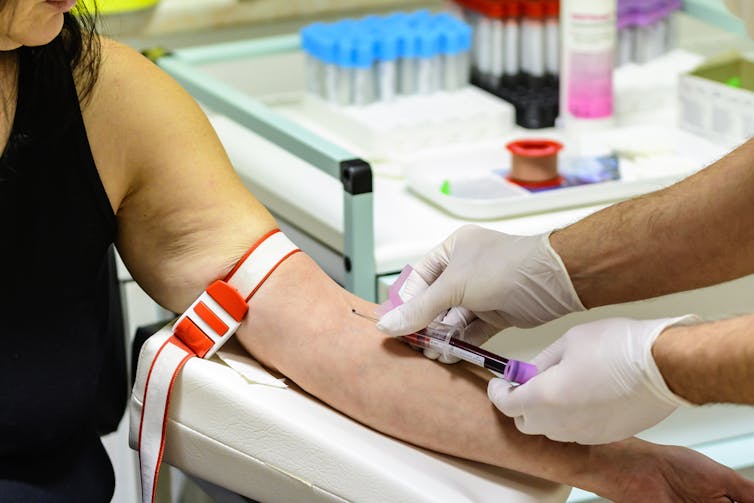Daryll Rowe is guilty – but is criminal law the right way to stop the spread of HIV?

Daryll Rowe infected five male sexual partners with HIV, and tried unsuccessfully to infect a further five.
Yesterday, he was convicted in the Crown Court at Lewes on ten counts of causing, and attempting to cause, grievous bodily harm. He will be sentenced in January.
This is the first case in the UK in which a person has been convicted of intentionally harming, or attempting to harm, others with HIV – prior to this, all UK convictions have been for reckless transmission. It is a uniquely harrowing and distressing case, and the impact of Rowe’s actions on the complainants cannot be underestimated.
Unsurprisingly, the trial has provoked much media comment, and his behaviour widespread condemnation – the details of Rowe’s actions, after all, are particularly shocking.

But whatever judgement we might pass on Rowe’s behaviour from a moral or ethical perspective, the criminalisation of HIV transmission and exposure more generally raises a number of important questions, not least regarding its impact on HIV-related stigma and efforts to reduce, and ultimately eradicate, the virus.
Ever since its discovery as the causative agent of AIDS in 1983, countries across the world have used the criminal law, both to censure those who have exposed others to the risk of infection or have in fact infected others, to control the spread of the virus.
The first of these rationales, a retributive one, reflected the fact that, until the mid-1990s, HIV was untreatable and almost inevitably led to death. It is therefore not surprising that states should have treated HIV as a weapon, and its effects as serious bodily harm.
The second rationale, a deterrent one, assumes that punishment will deter the accused – and others – from engaging in risky activity. It therefore has a supposed legitimacy from a public health perspective.
Both of these justifications are problematic.
The false path
Regarding retribution, criminal law requires that the defendant manifest a high degree of fault at the time – typically, that he acted intentionally, as Rowe did, or recklessly. As to intention, this can be established in English law and many other jurisdictions if (a) it is proven that it was the defendant’s purpose to infect, or (b) it may (but need not) be inferred if infection was virtually certain to occur, and the defendant foresaw that consequence as virtually certain.

Shutterstock
Proving purposive intention is extremely difficult – a deliberate intention to engage in sexual activity which carries with it the risk of onward transmission is not the same as intending to transmit. It is also very difficult, in the case of HIV, to establish intention in the alternative way because, as has been confirmed in a number of clinical consensus statements, from Canada, Australia, and Sweden, the probability of transmission in any one incident of sexual intercourse is extremely low.
What’s more, where a deliberate (but unsuccessful) attempt to transmit HIV during sex is prosecuted, is it legitimate to punish someone for failing to achieve a consequence which is, statistically speaking, extremely unlikely to materialise? Critically, in the case of HIV, the accused is unable, as a matter of fact, to exercise agency over the outcome. (There is arguably a difference between swinging a bat at someone’s knee and missing, and having sex during which a virus may, but on any one occasion probably won’t, infect a partner.)
Recklessness (the conscious taking of an unjustifiable risk), however, is a lesser form of culpability. It is easier to prove, and a far more common basis for criminalisation. Until now, reckless transmission has been the basis for all UK convictions.
Rowe was found guilty of intentionally harming, or attempting to harm, others with HIV. But criminalising reckless transmission is particularly problematic. From a retributive perspective, this amounts to punishing people living with HIV who have sex during which HIV is transmitted, not because they had any desire that this should happen but because they were aware that it might. This places the entire burden of minimising the risk on them (even in cases where a partner is in fact aware of the risks), and is even more problematic where reckless exposure (as opposed to transmission) is criminalised.
This is not just because no physical harm has been caused, but because there is an absence of clarity as to what degree of risk is acceptable. In Canada, for example, there needs to be a “significant risk”, though what this means is contentious. It is now widely accepted that when a person diagnosed with HIV is on effective treatment and has an undetectable viral load, transmission is all but impossible. In the words of a current, high-profile, campaign to encourage testing and treatment, Undetectable = Untransmittable, or U=U.
A deterrent?
Criminalisation can also create obstacles to delivering beneficial public health outcomes.
First, because a person living with HIV can only be convicted for transmission, attempt, or exposure if he knew his HIV positive status at the relevant time, those who are in fact positive but don’t know can’t, by definition, be deterred by the prospect of punishment.
Second, and critically, criminalisation contributes to the stigma associated with HIV infection. Sensationalist press coverage, focusing on exceptional “newsworthy” cases, does little if anything to normalise HIV infection or to inform the general public about the fact that the vast majority of people living with HIV take every precaution against putting partners at risk. Instead, it fuels ignorance and misunderstanding.

Shutterstock
Indeed, the print media in the UK and elsewhere has a long tradition of sensationalising HIV transmission and exposure cases, often at the expense of accurate reporting – whether about the trials themselves, or about the characteristics of those convicted.
This may make people wary of disclosing their status to partners, adhering to treatment, or getting tested in the first place.
Indeed, there is now near universal consensus among expert bodies, including UNAIDS and the Global Commission on HIV and the Law, that the use of the criminal law, where it is used at all, should be limited to the most egregious of cases and that exposure and reckless transmission should be decriminalised. Where states do use criminal law against those who deliberately and maliciously harm others, the highest standards of forensic evidence should be deployed.
Any moral judgement we pass on defendants in particular cases (who, it is worth remembering, were themselves infected by someone else) should not deflect attention from what must be our main priority: the total eradication of HIV.
We know definitively that regular testing and early treatment can significantly reduce the number of new infections, and we know that stigma, fuelled by criminalisation and press coverage, impedes this.
Rowe’s behaviour was found to be criminal. But we should reflect on whether criminal law – in general – does more harm than good, and ensure wherever, and whenever, possible that HIV is understood and treated as a public health priority rather than as an opportunity for blame and punishment.
Matthew Weait, Professor of Law and Society and Dean of the Faculty of Humanities and Social Sciences, University of Portsmouth
This article was originally published on The Conversation. Read the original article.

